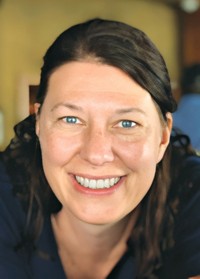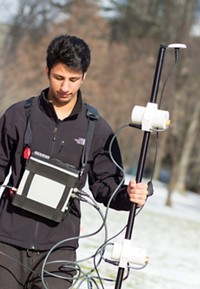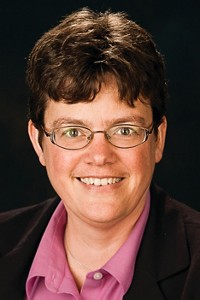Advertisement
Grab your lab coat. Let's get started
Welcome!
Welcome!
Create an account below to get 6 C&EN articles per month, receive newsletters and more - all free.
It seems this is your first time logging in online. Please enter the following information to continue.
As an ACS member you automatically get access to this site. All we need is few more details to create your reading experience.
Not you? Sign in with a different account.
Not you? Sign in with a different account.
ERROR 1
ERROR 1
ERROR 2
ERROR 2
ERROR 2
ERROR 2
ERROR 2
Password and Confirm password must match.
If you have an ACS member number, please enter it here so we can link this account to your membership. (optional)
ERROR 2
ACS values your privacy. By submitting your information, you are gaining access to C&EN and subscribing to our weekly newsletter. We use the information you provide to make your reading experience better, and we will never sell your data to third party members.
Careers
Is it time to leave behind chemical engineering accreditation?
Caltech and Stanford plan to drop ABET to modernize their curricula and offer students more flexibility, but others still see value in the standards
by Celia Henry Arnaud
December 4, 2017
| A version of this story appeared in
Volume 95, Issue 48

ABET, formerly the Accreditation Board for Engineering & Technology, has been evaluating and endorsing chemical engineering programs at universities in the U.S. since the 1930s. California Institute of Technology was one of the first to have its program accredited by ABET in October 1936.
Despite that long history, Caltech’s chemical engineering department has now decided that neither it nor its students benefit from the ABET stamp of approval. The department decided last year and publicly announced this fall that it would no longer pursue accreditation and published an open letter on its website.
And Caltech isn’t alone. At their annual retreat in September, the chemical engineering faculty at Stanford University voted to withdraw from the ABET process as well. More universities may follow suit.
Seven engineering societies, including the American Institute of Chemical Engineers, or AIChE, originally founded ABET to establish criteria for the professional development of engineers and to protect public safety by making sure engineers meet certain standards. Since shortly after its founding, the organization’s main task has been the accreditation of educational programs.
ABET focuses on student outcomes
In the late 1990s and early 2000s, ABET switched from a focus on what students are taught to what they learn—officially called student outcomes. These outcomes, which emphasize “soft skills” such as communication proficiency, can be difficult to assess and document. Starting with the 2019–20 accreditation cycle, the number of outcomes will drop from 11 to the seven abilities listed below:
Identify, formulate, and solve complex engineering problems by applying principles of engineering, science, and mathematics
Apply engineering design to produce solutions that meet specified needs with consideration of public health, safety, and welfare, as well as global, cultural, social, environmental, and economic factors
Communicate effectively with a range of audiences
Recognize ethical and professional responsibilities in engineering situations and make informed judgments, which must consider the impact of engineering solutions in global, economic, environmental, and societal contexts
Function effectively on a team whose members together provide leadership, create a collaborative and inclusive environment, establish goals, plan tasks, and meet objectives
Develop and conduct appropriate experimentation, analyze and interpret data, and use engineering judgment to draw conclusions
Acquire and apply new knowledge as needed, using appropriate learning strategies
Source: ABET
Every six years, ABET-accredited programs must go through an evaluation process that starts with a self-study. As Caltech began preparing for its self-study in the fall of 2016, the faculty started bracing themselves to deal with objections they’d received from ABET evaluators in years prior and were sure to receive again, says Richard Flagan, a professor who has shepherded the chemical engineering program through ABET’s process for multiple cycles.
“We started discussing what is ABET doing to our ability to allow students to take full advantage of Caltech in their education,” Flagan recalls. “We ultimately came to the conclusion that ABET was blocking our students from getting the best possible education. We did this to allow our students some flexibility in designing programs that will take them down the paths they plan to pursue.”
At Stanford, this move had been coming for a while, says Eric S. G. Shaqfeh, chair of the chemical engineering department. He previously served as the program’s ABET officer through two reviews. “We had discussions before we were accredited last time about whether this was making our program better and whether it was worth the cost and effort,” he says. “Unfortunately, over time, the answers to those questions became no.”
The cost of maintaining accreditation often runs into six figures in terms of personnel time and direct costs. Individuals shepherding the process for their program also have to go to conferences to determine how to remain ABET accredited, Shaqfeh says, and understanding the criteria can be a challenge. “Frankly, it’s a moving target,” Shaqfeh says. “A number of institutions hire ABET consultants, usually ex-ABET reviewers. We did not do that, but we were on the verge of realizing we would probably have to.”
Joe Sussman, chief accreditation officer and chief information officer at ABET, maintains that the process isn’t as onerous as some institutions make it out to be. He also says that the process does allow flexibility in designing educational programs. The accreditation criteria are a set of eight broadly worded statements with plenty of room for interpretation by individual departments. The criteria no longer tell programs what courses to teach.
In the late 1990s and early 2000s, ABET overhauled its requirements, moving away from what many consider “bean counting,” laying out the exact content that engineering programs were expected to teach, and toward a more general approach.
“Before 1995, we spent a lot of time, effort, and energy measuring what students were taught. The faculty liked that because they could just count the number of credit hours that were being delivered for physics, chemistry, math, and engineering topics,” Sussman says. “Under pressure from industry, we transformed the accreditation process.”
Industry was worried that students weren’t actually acquiring all the skills they needed, says Sussman, who was a senior executive in industry before joining ABET. While their technical skills were solid, the students were lacking the “soft skills,” such as the ability to work well in teams, they needed to succeed in their careers. In response, ABET’s focus switched from what was taught to what students actually learned, so-called student outcomes. “We asked programs to devise, develop, and execute an assessment and evaluation system to assess achievement of the learning outcomes, which were articulated in terms of skills and abilities,” Sussman says.
One of the intentions is to give programs enough flexibility to allow them to differentiate themselves, Sussman says. “We want our programs to be different, but we want them to be able to measure their performance against their own key performance indicators,” he says. “All we do is go every six years to see if the process is working.”
But the promised flexibility hasn’t necessarily been the experience of programs come evaluation time. “The first examiner we had under that system mandated that we reintroduce a course we had dropped because it did not serve our students,” Caltech’s Flagan says.
Caltech and Stanford have both faced examiners who questioned in which courses specific engineering content was taught and examiners who challenged the balance between their basic sciences and engineering course content. Without specifying which classes should be taught, the ABET criteria call for a year, or 30 units, of basic math and science and a year and a half, or 45 units, of engineering topics in accredited programs.
“If we look at our bio track, a lot of what students need is taught in courses with labels of biology or biochemistry. Those courses are teaching methods to do design—the things that engineers do—but they don’t happen to have an engineering label,” Flagan says. “We found ourselves restricting students from pursuing courses that were really central to where they wanted to go to satisfy a label requirement that was put on us, not by the ABET rules, but by the ABET examiners.”
In a similar situation, the Stanford chemical engineering program was using a chemistry course to teach some engineering fundamentals. The ABET examiners disallowed it because it wasn’t taught by an engineer. “They doubted whether a chemist could provide the engineering fundamentals for our program,” Shaqfeh says.
Randy S. Lewis, a chemical engineering professor at Brigham Young University, has served as an ABET evaluator and a member of ABET’s Engineering Accreditation Commission. In addition, he is chair of the Education & Accreditation (E&A) Committee of AIChE, which is a member organization of ABET and is responsible for ABET’s discipline-specific chemical engineering program criteria. The E&A Committee recruits evaluators.
“There has been a great effort to provide consistency in the evaluators,” Lewis says. The evaluators go through rigorous online and in-person training at ABET headquarters. AIChE also provides training. Before serving as an official evaluator, an individual tags along with a seasoned one.
And once the evaluations are done, there’s a process to make sure that the results are consistent across programs and institutions. “Every July, the E&A Committee does a consistency analysis of every chemical engineering program that was reviewed that year. We make sure there’s consistency among the findings,” Lewis says. “We don’t want one evaluator to say one thing and another one to have a similar situation but give them different shortcomings.” In an evaluation, a program receives a grade of “shortcoming” or “no shortcoming” for each of the criteria. Any shortcomings are further labeled as a deficiency, a weakness, or a concern, in order of decreasing severity. In addition to AIChE’s consistency check, ABET’s Engineering Accreditation Commission also does an extensive consistency check across all programs before voting on the final accreditation action.
A sore point for top-tier programs is that they tend to get evaluators who are not from what they would consider peer institutions. Sussman realizes that’s an issue and attributes that to lack of engagement of elite institutions. When he did a quick search of ABET’s evaluator database, he found a total of only three evaluators across all disciplines from a select group of 12 universities (Ivy League plus Caltech, Stanford, Massachusetts Institute of Technology, and the University of California, Berkeley). “We have over 2,000 volunteer experts,” he says. “We do the best we can with the talent that has stepped up. This is a volunteer process.”
One way that dropping accreditation could negatively affect students is if they want to pursue what’s called a professional engineer (PE) license. Most states base their licensure requirements on the National Council of Examiners for Engineering & Surveying (NCEES) model law. Under that model, the process for becoming a PE involves a combination of education, experience, and examination. For students graduating from an ABET-accredited program, the time spent attaining a degree can count as part of the required experience. Students in accredited programs are allowed to take the Fundamentals of Engineering exam, the first of two exams required for licensure, before they graduate. Engineers who pass the first exam need a minimum of four years of practical experience before they can take the second exam. The rules vary by state, but graduates of non-ABET-accredited programs may need to prove that their program is equivalent or that they have more practical experience before they can take the first exam. Thus, the path to PE licensure, while not completely cut off, could be longer or more arduous. Pursuing PE licensure is more common in mechanical and civil engineering than in chemical engineering.
The National Society of Professional Engineers supports the NCEES model law, says Arthur Schwartz, the deputy executive director of the society. “We think the rigorous requirements of accreditation are an important element in making sure that those requirements are in force,” he says. “We would not be in favor of moving away from the ABET [Engineering Accreditation Commission] requirement for licensure.”
Neither Stanford nor Caltech thinks its students will be adversely affected by the hurdles to PE licensure. Since 1993, only 0.3% of Caltech’s chemical engineering undergraduates have received a PE license.
Both Caltech and Stanford hope dropping ABET accreditation will be an opportunity to revamp their curricula. “We want to create a modern curriculum that will benefit Stanford students and prepare them to be leaders in chemical engineering,” Stanford’s Shaqfeh says.
At Caltech, chemical engineering has, until recently, had more requirements than any other discipline at the university. Faculty efforts to reduce the number of credits required for a chemical engineering degree to that required for any other degree at Caltech while still satisfying ABET left students with only one free elective. Dropping ABET opens the door for students to incorporate other courses or undergraduate research into their studies.
Students at Caltech and Stanford responded enthusiastically when the departments explained that they were dropping ABET accreditation. The current freshmen and sophomores at Stanford—those who will be the first affected by the change—are disappointed that the curricular shift probably won’t come fast enough for them to benefit, Shaqfeh says.
In addition to Caltech and Stanford, Massachusetts Institute of Technology is preparing to redesign its chemical engineering curriculum. Paula Hammond, head of MIT’s chemical engineering department, charged her faculty with designing a curriculum at the vanguard of chemical engineering without regard to how it might influence the program’s ABET accreditation.
“I strongly believe the curriculum should be driven by faculty,” she says. “We have a better idea of the changing frontiers of chemical engineering education, and we need freedom to design the curriculum without having to fit it into some prescribed notion of chemical engineering, especially if it’s not an adaptive one.”
Because MIT is at a different point in its ABET accreditation cycle, the chemical engineering department can undertake such a revamp without having to worry—yet—about ditching ABET. “We might share it with ABET so they know what they’ll be looking at once we decide what we want,” Hammond says. “As we move toward evolving the classes we present, we will hopefully be able to work with ABET to help them understand that this is how we view a changing chemical engineering field. If there is some difficulty in agreeing on what engineering content is, I would go with what my faculty thought engineering content was.”
Each of these departments thinks that ABET accreditation is no longer serving the useful purpose it once did—at least not for their departments. And none of them plan to stop evaluating their own programs. “Looking at what your program is doing is critical,” Flagan says. “We’re not going to stop doing that.”





Join the conversation
Contact the reporter
Submit a Letter to the Editor for publication
Engage with us on Twitter